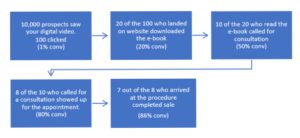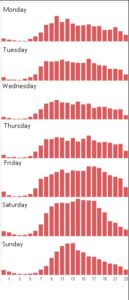Scale Marketing is a Media Strategy and Data Analytics firm located in Chicago and Dallas (www.scale-marketing.com). Our team consists of former business owners, operators, CMOs, and media executives.
Scale was formed to help Small and Mid-Sized businesses implement and improve on the Marketing best practices we developed through our collective work history.
This article outlines the fundamentals for building effective internal marketing systems and implementing them into your external marketing efforts.
These aren’t “theories”. These are best practices we used to grow our own companies; As well as insights we’ve gained through collaboration with our clients. They are meant to be top-line tips and thought starters. If you’d like to continue the conversation feel free to reach and connect with us.
Summary Outline
Section 1: Building Actionable Data Systems
In Building Actionable Data Systems we begin the conversation on the importance using a CRM to track and store your data for both internal sales and external marketing uses.
Section 2: Using Data to Better Understand Your Customers
In Using Data to Understand Your Customers we discuss techniques businesses can use to better understand who their best customers are and how they think.
Section 3: The Importance of Media Consumption Studies
In The Importance of Media Consumption Studies we look at the critical process of studying and optimizing your media strategy based on evolving trends in media consumption habits by generation.
Section 4: Establishing Key Performance Indicators (KPIs)
In Establishing Key Performance Indicators we examine the critical importance of establishing KPIs which unique to your business and the dangers of following “Industry Standards”.
Section 5: Media Architecture
In Media Architecture we illustrate the process and importance of using data to align your message with your customer’s shopping cadence
Section 6: Attribution and Visualization
In Attribution and Visualization we outline the importance of aligning your media performance with your revenue to identify the media channels that are providing the best ROI. We also touch on software that can help bring your insights to life visually.
Section 7: Plan and Negotiate to Win
In Plan and Negotiate to Win we discuss the importance of implementing your KPIs and Sales data into your media planning and negotiations.
Section 8: Holding You Media Partners Accountable
In Holding Your Media Partners Accountable we create visibility on how media inventory works and the importance of holding your media partners accountable to your RFP
Section 9: Deciding What and When to Outsource
In Deciding What and When to Outsource we examine the value vs. expense of using outside resources to develop and execute the steps above.
Section 10: Be Curious, Never Stop Measuring and Learning
Section 1: Building Actionable Data Systems
No word has created as much business buzz in the last 10 years than “data”. Four small letters with seemingly infinite uses. Big Data, Little Data, Qualitative Data, Quantitative Data….the list goes on and on. In our experience, especially as it relates to helping Small and Mid-Sized businesses market themselves, the most important Category type to describe your data isn’t a Category at all. It’s an adjective; Actionable, and if you want to steadily increase revenue, time management, marketing efficiency and overall profitability.
Actionable is the most important moniker your data can carry.
So how do you take the volumes of raw data most companies harvest and make it Actionable? The first and most fundamental step is researching and implementing a nimble CRM system. There are a lot out there so emphasis on the word “research”.
You can start with sites like PCMag (http://www.pcmag.com/article2/0,2817,2367263,00.asp) to see the entire field and begin to dial in your choices. Every business is different but the most important output is to find one that can solve your current needs without becoming a bottleneck as you grow. It’s easier said than done though.
If you’re a Start Up you’re cost conscious; weighing every decision on current value vs expense. If you’re a Mid-Sized business whose been around for years your current systems may seem adequate. In both instances, if you underestimate the importance of a good CRM, you are lighting the fuse on a data expense bomb which will inevitably go off.
Whether it be people, financing, or product evolution. You have, or will, spend a lot of time planning for the future growth of your company. Make sure your customer data management infrastructure receives similar foresight. Done properly, the organization and automation of your historical raw data will soon prove to be the foundation for thousands if not millions of actionable analyses on your current and future customers.
Here’s a couple articles you might find helpful…..http://www.businessnewsdaily.com/7839-best-crm-software.html https://www.g2crowd.com/categories/crm
Section 2: Using Data to Better Understand Your Customers
There’s no denying the value of a reliable “gut” feeling when making marketing decisions. It’s your product/service, your passion and your business. Who would know it better than you? Probably no one. That doesn’t mean you ignore helpful insights, which are readily available, to confirm your feelings.
There’s no better way to ensure your instincts are correct than by using your now Actionable data to confirm who your best customers are before you invest finite marketing dollars into a campaign.
More times than not, Small and Mid-Sized businesses rely on generic information (age, gender, geo- location…etc) to develop their customer profile and go-to-market strategy. While they should be incorporated into the analysis, these attributes tell half the story if not less. There is a wealth of information available that goes beyond what someone looks like or where they live. These insights give you visibility on the behaviors that serve as precursor to purchase. Once you have access to this level of information you can predict what inspired people to purchase your product, when they will purchase again and the journey they will take to find you. These insights even help uncover the messaging that will push them off the fence and into your customer database.
Companies like Claritas (www.claritas.com) offer products which can help you translate your Actionable data and tell your customer’s story. This in turn will help you attract new customers more effectively, message to them more efficiently….. and potentially expose new markets.
There are no guarantees in marketing. However, armed with these empirical insights, your time tested “gut feeling” will be exponentially more impactful with your misses considerably smaller.
Section 3: The Importance of Media Consumption Studies
Your data is clean and actionable. Your audience segmentation is now on point. You know who your customers are and how they think. Fantastic! The only question that remains is how and where you can reach them? If you haven’t been exposed to media consumption studies in the past you’ll quickly find that the modern day consumer is a moving target. Each having access to a virtual mosaic of media platform options which, at a high level, fall into three main channels; Video, Audio and Social. Each platform can be consumed from any variety of devices a consumer likes best.
Video
Broadcast TV Cable
Connected TV Devices PC Video
Smartphone Video Tablet Video
Audio
Broadcast Radio PC Streaming
Smartphone Streaming Tablet Streaming
Social
Smartphone App& Web Smartphone Social Networks PC Social Network
Tablet Social Network
Creating the content for these platforms are hundreds of companies supporting thousands of individual channels attracting millions of consumers (insert maddening scream). Take Saturday Night Live for example. If you find your audience aligns well with the content, you can reach them on Broadcast TV, your local cable providers, YouTube (https://www.youtube.com/user/SaturdayNightLive) or via their Facebook page (https://www.facebook.com/snl/). Which platform(s) you use could drastically change depending on the age range you’re targeting and your company’s KPIs. Thus the need to study your consumer’s media consumption habits. You get the point.
Suffice to say, it’s fractured media environment. Don’t panic though. There are plenty of resources and research available to you. Nielsen’s Comparable Metrics Report is a great place to start. (http://www.nielsen.com/content/dam/corporate/us/en/reports-downloads/2017-reports/q3-2016-comparable- metrics-report.pdf) From there you can pivot to industry specific studies like E-marketer (http://www.emarketer.com/corporate/coverage#/) for a more granular look at the Digital space.
Just remember, media consumption habits change as consumer’s needs change. This is not a static environment. You should follow these trends to make sure your message is delivered across platforms relevant to your consumers. A little research will ensure you’re reaching the right people at the right time in the right environment.
Section 4: Establishing Key Performance Indicators (KPIs)
Section 4 assumes 1-3 have been implemented. If you’re a Start Up by now you’ve tested your media and have enough data to begin establishing your KPIs. If you’re a mature Mid-Sized business you probably have enough Actionable data to draw from already. Either way, it’s time to formulaically reverse engineer your success in anticipation of optimizing your future marketing strategies. These road maps to success are often referred to as KPIs or Key Performance Indicators.
Before moving into this section it’s important to first note that KPIs simply represent the path between a business result you’ve identified and the starting point from which a consumer began their journey. They can be universally applied to any conversion (and these are just a few) whether it be closing a sale, opting in to your e-mail database, creating of a new account or downloading an app.
Regardless of the conversion you’re tracking, the critical solve is understanding the path and the % of consumers who move through each step of the process. Ultimately the path and your conversion ratios will help you engineer your campaigns and improve your effectiveness. This way you can efficiently replicate and improve the process with future prospects. For example purposes, let’s assume you own a laser eye center…..
ABC Laser Eye Surgery Center
If this was an actual proven KPI model, the business owner would know that he/she will convert (on average)7 customers from every 10,000 media impressions delivered. Assuming the marketing dollars spent vs the net revenue was an acceptable ROI, this process could be replicated and improved during subsequent campaigns through a variety of methods. There are countless applications of this process in the business world. The most important takeaway is simply this; KPIs help show you see the path. If you know the path, you can predict the future.
Section 5: Media Architecture
In section 4 we looked at the importance of establishing your own unique KPIs for the purpose of improving your marketing effectiveness. One area you can make an immediate impact is in your Media Architecture.
Media Architecture is the process of aligning your message with the stages of your customer’s purchase cadence. By studying your marketing metrics you will begin to delineate between when your customers are shopping and when they’re actually making a purchase. Once you recognize these stages you can shape your media spend to ensure you’re applying the maximum amount of media weight and messaging at the right time.
For instance, if you know your sales spike on weekends but see your website traffic and Click Through Rates growing after hours on Sunday nights, you know customers are beginning to shop for the following weekend. Similarly, if you see both traffic and CTRs fall on Monday nights it’s best to minimize your weight so you aren’t throwing good impressions against a historically bad shopping night.
By tracking similar patterns through the week you’ll be able to predict the best days and hours to apply your media weight. You can also test different creative lengths and messaging to optimize toward the best sales results.
Section 6: Attribution and Visualization
You’ve probably heard the old adage “I know that 50% of media is working, I just don’t know which 50%”. Advertising technology has come a long way since that phrase was coined but the reality is that consumers are surrounded by a symphony of media. They may hear your commercial on the Radio, then see it the next day on a Billboard, then see your video on a YouTube pre-roll……but not take action until two weeks later when they search your name on Google. Paid Search would get credit but they wouldn’t have known about you unless previous media exposure had created the awareness. Next thing you know you’re cancelling media that’s actually driving business results; you just don’t know it. So how do you begin to analyze what is and isn’t working?
As best you can (depending on your business), assigning unique tracking numbers, landing pages and promo codes will help you directionally see where your business is coming from…but I emphasize the word directionally for all of the reasons above. You can take it one step further by incorporating Ad Tech like Placed.com (www.placed.com ) or LiveRamp (www.liveramp.com). These technologies allow you to attribute direct sales to consumers who received your messages. They also help you see the path they took to find you.
Once you have your attribution systems in place there are a wealth of analytics products available to help you organize your data and line it up with your other business KPIs. This way you can see which media channels are driving your business. Tableau is a great example (www.tableau.com). Software like Tableau creates a direct connection into your CRM and allows you to quickly organize your data into actionable insights in visual form. From there you can manipulate and dissect the data…..if you’re brave enough you can even create predictive analytics.
Section 7: Plan and Negotiate to Win
So let’s pause for a moment and reflect.
- We started by getting our data into and organized and actionable
- We discussed analytics tools that can help translate your CRM data into customer profiles so you can better understand who is buying and
- Knowing your customer, you researched the best mediums and channels to reach them with via a Media Consumption
- You established your KPIs to chart the path to
- You’ve shaped your media around your KPIs to maximize your media weight in the
- FINALLY, you invested in attribution software and maybe even analytics tools like Tableau to study your media effectiveness.
- Congratulations! You know more about your business than ever before!
Now comes the critical moment when you have to plan and negotiate your next media launch. The moment where, regardless of your best laid plans, everything can fall apart.
If you’ve done everything right, you should have a pretty good idea how much you need to budget and where to invest the dollars. Taking it one step further, if you’ve thoroughly studied your data you probably have a good understanding of how many impressions (by medium) you need to generate a lead and ultimately a sale. Time to negotiate to win. Which means, structuring your media so you have an acceptable ROI vs media spent.
The term “Negotiate to Win” shouldn’t evoke an image of a merchandise bazaar in a far off land. Armed with the information above, your RFP should be a surgical like blue print to success with specific parameters in place which reflect your KPIs and data insights. When you combine your KPIs, consumer data insights and your CPL/CPA formula, you have a recipe for success. If you follow it correctly and negotiate with thoughtful purpose you will have put yourself in the best position to be successful.
Forewarning though. If the campaign isn’t structured well it will be over before it begins. Take your time to develop the plan. It’s not impossible, but once the wheels are in motion it can be hard to unwind things mid-campaign. Oh and one more thing……
Section 8: Holding Your Media Partners Accountable
You have to hold your media partners accountable if you want your campaigns and ultimately your business to be successful. They can inadvertently and quietly erode your marketing strategy from the inside out without you ever knowing. It’s not because they’re bad people and they don’t like you. It’s not because they don’t value your business. It’s just bandwidth.
Local market media companies can have hundreds if not thousands of clients on in any given year. While the best intentions may be there, they simply can’t watch everything and sometimes automation can work against them. Even if you negotiated a deal expecting certain levels of performance, audiences fluctuate. In the Traditional media space ratings can change, audiences can drop, rotations can fall unevenly…..the list goes on. The Digital landscape is not without it’s own challenges either. These issues can actually be worse as they will report successful metrics without recognizing fraudulent activity.
Case in point. Lets say you generate a close for every 12,000 impressions delivered. To ensure you hit your ROI, you structure your Broadcast TV program to generate 150MM impressions per year over a specific audience. However, ratings delivery can fluctuate 10%-20% per month. If that sustains through the year your impression delivery can drop 10%-20%…which means your leads will follow suite.
The takeaway is simple It’s your money. No one is going to be as vigilant as you. You have to be involved or make sure the right people are in place to steward the business. Post your media at least once each quarter for Traditional Media. In the Digital space, make sure you have 3rd party verifications in place for all campaigns. It’s the only way you can be sure you got what you paid for.
Section 9: Deciding What and When To Outsource
So when does all this become to much for you or your team’s bandwidth? The question is as old as business itself…..and so is the answer. Until the benefits no longer outweigh the cost. A breaking point only you will truly recognize. How fast the bandwidth changes depends on how fast you grow.
Like any industry, things move fast and change fast in the world of Marketing. In the time you’ve taken to read this there have probably been two new Ad Tech companies launched and 4 that failed. The space is evolving quickly. The best advice we can give any Small or Mid-Sized marketer is to embrace the fact that you don’t know what you don’t know. It never hurts to call a subject matter expert in to discuss advances in the world of Marketing and specifically what their value proposition is for your business.
You may find out you’re in great shape and your team’s more than capable of handling the task at hand. Then again, you may find out you’ve been overpaying for the last 5 years and you’re wasting money targeting the wrong consumer on the wrong media channel. Either way, a periodic conversation with experts in the industry will serve as an insurance policy for your business.
Section 10: Be Curious, Never Stop Measuring and Learning
The 9 sections prior are high level suggestions to help you on your way to improved marketing effectiveness. They’re just the tip of the iceberg though. Where you go from here is up to you. Section 10 is purposely blank because it’s yours to write.
You know your business better than anyone. Never stop developing your own “best practices”. In our opinion, section 10 should metaphorically remain eternally empty. If for no other reason than as a reminder that you’re never done learning and evolving your tactics. The day you think you are is the day your competitor will pass you by.
Thank you for reading and if you’d like to continue the conversation feel free to contact me at [email protected] .






